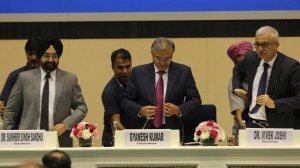Stay updated with the latest - Click here to follow us on Instagram
Ways of Seeing
A handbook to the glorious era of Indian silent films
Of the about 1,300 or so silent films made in India, only about one per cent survive. And those too, not in their entirety. Scholars, researchers and interested viewers have had to make do with the scantiness of movie-making material in India when it could only be seen, not heard. Which is why, any fresh work on this era is a matter of celebration.
Film historian Suresh Chabria revisits the territory laid out in the first Light Of Asia: Indian Silent Cinema, 1912-34, and you can see why there needed to be a “revised and expanded” version. In the intervening 20 years (the first edition came out in 1994, as accompaniment to the first-time comprehensive retrospective of Indian silent films in Pordenone, the north Italian town which hosts the largest annual film festival of the kind), more films, or their bits and pieces, have been discovered, and much more work has been done.
The latest edition includes a detailed filmography of the silent cinema titles now identified, as well as a bibliography of all the new research that’s come out since. That makes it an invaluable resource for a new generation of scholars and researchers. But it is also a great handbook for those who want to know more about a glorious era of filmmaking, what Chabria calls the “lost cinematic paradise”: here lived the pioneers who made a leap of faith and imagination and technology, and laid the foundation of what is considered the world’s largest film industry.
Dadasaheb Phalke is the best known and the most celebrated of the great silents, mainly because much of his work has survived. His life and times were beautifully captured in a recent Marathi film, and though Harishchandrachi Factory was a biopic, it captured the zeitgeist: how, under British rule, it was virtually impossible to do anything that was un-circumscribed, but how he managed to break through; how cameras were brought in from the UK, and how learning and technology were transferred, and creativity unleashed.
The British rulers were looking for subversive “nationalistic” elements in indigenous films. They let mythologicals and devotionals past censorious eyes. As well as historicals, stunt films, comedies and thrillers. So why is it that when we think of our early cinema, we think only of mythologicals? What happened to the films made in all these other genres? Did Phalke’s primacy obscure other equally talented contemporaries: what happened after the early silent filmmaking flurry in Bengal and in the south?
A thought-provoking essay by Ravi Vasudevan picks up a crucial point from Kaushik Bhaumik’s thesis which talks of how the small number of (extant) films that have survived has had a curious consequence: “it has quite unproblematically allowed this small number to stand in for India’s silent cinema as a whole”. The twinning of the mythologicals and the Swadeshi movement inevitably drowned out other kinds of cinema, making mythologicals the dominant genre, and “also allowed the absorption of a modern technological medium like cinema into Indian ‘tradition’”.
What if, for example, an adventure or a thriller or a B-grade action movie (starring, say, a non-Indian female face, because no woman from a “good family” was then seen on screen) had become India’s “first” film? What if it hadn’t been a mythological, revered through centuries? Would the course of Indian cinema been radically altered? Would what is considered “traditional” and “permissible” in today’s time been completely different? Would the kiss, for argument’s sake, been “allowed” unfettered in Indian cinema (pre-Independence Indian movies showed kissing as a perfectly indigenous activity, but post 1947, it became dangerously Western and subversive)?
The volume has a treasure trove of photographs, posters and publicity booklets. Look at the one in which a beauty reclines across a couch in a hand-painted, oil-on-canvas poster for a film called Gallant Heart presented by a Sham Sunder Agarwal. Or a Saroj Film presentation of Fighting Blood, starring Chandrarao and Zeboonisa, with a red-faced, scowling djinn towering over a female holding a sword. They look their age, these representations. And they bring us back to a time when it was the eye that did most of the work, and the ear was still to come.







